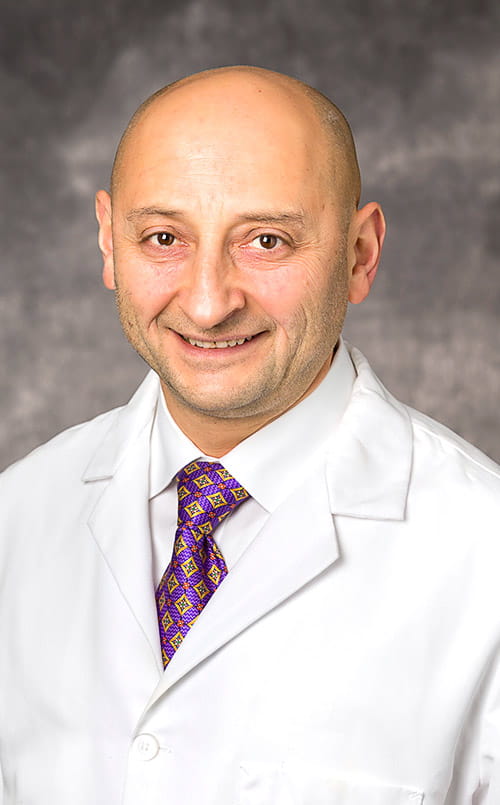University Hospitals Builds on Its Pioneering Work in Diaphragmatic Pacing to Benefit Lung Transplant Patients
February 01, 2022
UH Cleveland Medical Center has the most experience in the world using DP technology with these patients
UH Cardiovascular Medicine & Surgery | Winter 2022
The pioneering work done with diaphragmatic pacing (DP) at University Hospitals Cleveland Medical Center, combined with increased demand for ventilators during the COVID-19 pandemic, have led to an unexpectedly positive outcome for a novel group of patients benefiting from DP technology – those undergoing lung transplantation. In fact, UH Cleveland Medical Center now has the largest clinical experience using DP for these patients.
Raymond P. Onders, MD, FACS, Chief of General and Gastrointestinal Surgery and Director of Minimally Invasive Surgery at University Hospitals Cleveland Medical Center, and his team of researchers developed a diaphragm pacing system in 2000 – a system that improves the functionality of the diaphragm in patients using ventilators. Dr. Onders is also Margaret G. and Walter K. Remen Chair in Surgical Innovation and Professor of Surgery, Case Western Reserve University School of Medicine.
In April 2020, Dr. Onders applied for and received approval from the U.S. Food and Drug Administration for emergency use of the TransAeris Diaphragmatic Pacing Stimulator System for any patients at risk for prolonged mechanical ventilation, including patients with COVID-19. He and the heart and lung transplantation team at University Hospitals Cleveland Medical Center quickly capitalized on this development to provide DP therapy to lung transplant patients. So far, the UH team has provided either chronic or temporary DP to 16 lung transplant patients.
 Yakov Elgudin, MD, PhD
Yakov Elgudin, MD, PhD“It’s not by chance that University Hospitals Cleveland Medical Center has the largest clinical experience with this technology,” says Yakov Elgudin, MD, PhD, Surgical Director of Lung Transplantation Program at University Hospitals Cleveland Medical Center, who has been deeply involved with the care of these patients. “Dr. Onders is a champion and world-recognized leader in the whole idea and clinical application of DP, so we benefit from his expertise tremendously. DP in lung transplantation had been examined at other places, both in the U.S. and in Europe, however, the experience is quite limited at other institutions. Here, over a very brief period of time, we were able to implement DP, both chronic and temporary, very aggressively and very quickly with a large number of patients. To date, the experience we are reporting is the largest number of lung transplantation patients with the DP system.”
Dr. Onders, Dr. Elgudin, Dr. Yasir Abu-Omar and other University Hospitals Cleveland Medical Center colleagues have reported their results in an abstract in the Journal of Heart and Lung Transplantation. Among the first eight lung transplant patients treated with DP at University Hospitals Cleveland Medical Center, three patients with diaphragmatic dysfunction, six months average post-transplant, had chronic DP implanted. All had evidence of subsequent recovery of diaphragm function. One patient had DP pre-transplant for unilateral diaphragmatic dysfunction with subsequent diaphragm recovery. Four patients underwent implantation of temporary DP electrodes during lung transplant. Two patients had bilateral dEMG identified post-operatively with uneventful recovery and removal of electrodes. Two patients had no dEMG activity or movement bilaterally post-operatively – which was a pre-operative condition. One recovered diaphragm function after two weeks with DP therapy. The other is still undergoing DP.
Dr. Elgudin says he hopes these promising results will encourage lung transplantation teams across the country and the world to give serious consideration to the benefits of DP for their patients.
“We feel that all patients with bilateral lung transplantation or even unilateral lung transplantation would benefit from temporary DP at the time of surgery,” he says. “That’s our experience. Even if we don’t have any technical concerns, phrenic nerve dysfunction post-transplant is ubiquitous. The degrees of phrenic nerve dysfunction and diaphragmatic dysfunction after lung transplantation can vary from mild to moderate to very severe, but even if it’s a temporary phrenic nerve dysfunction, the fact that we can stimulate the diaphragm with this temporary pacing improves the patient’s ability to wean off the ventilator and rehabilitate better and progress with their recovery. In all, we have seen a very positive influence of DP on multiple lung transplantation patients. It’s not something that will be a universal panacea for all the issues, but it certainly helps people to get off the ventilator faster and progress to come off the diaphragmatic pacing and return to normal ventilation quite expeditiously. I do believe that the as we gain more and more experience, the results will be very positive and the technology will be used widely.”
For more information, contact Dr. Elgudin at 216-844-4004.
Contributing Expert:
Yakov Elgudin, MD, PhD
Surgical Director, Lung Transplantation
University Hospitals Cleveland Medical Center
Cardiac Surgeon
University Hospitals Harrington Heart & Vascular Institute
Assistant Professor
Case Western Reserve University School of Medicine


